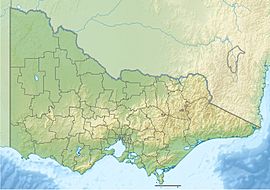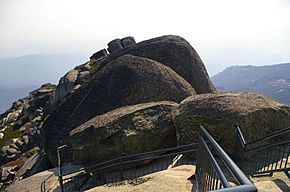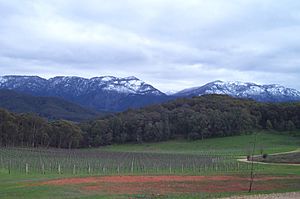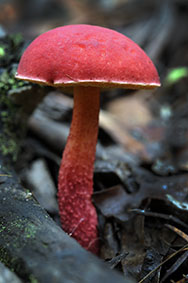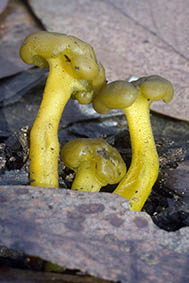Mount Buffalo National Park facts for kids
Quick facts for kids Mount Buffalo National ParkVictoria |
|
|---|---|
|
IUCN Category II (National Park)
|
|
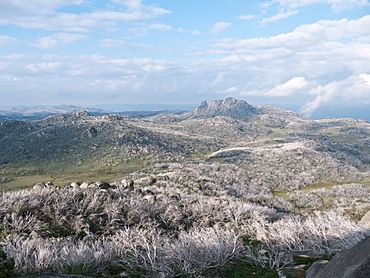
Mount Buffalo plateau as seen from below The Horn.
|
|
| Nearest town or city | Porepunkah |
| Established | 1898 |
| Area | 310 km2 (119.7 sq mi) |
| Visitation | circa 200,000 (in 1996) |
| Managing authorities | Parks Victoria |
| Website | Mount Buffalo National Park |
| See also | Protected areas of Victoria |
The Mount Buffalo National Park is a special national park found in the alpine mountains of Victoria, Australia. This huge park covers about 31,000-hectare (77,000-acre) (that's 310 square kilometers!). It's located around 350 kilometres (220 mi) northeast of Melbourne.
Inside the park, you'll find Mount Buffalo. This is a mountain plateau (a flat-topped mountain) that stands 1,723 metres (5,653 ft) above sea level.
Mount Buffalo National Park is one of Australia's oldest parks. It was first set aside on 4 November 1898. Back then, it was 1,166 hectares (2,880 acres) around the plateau and Eurobin Falls. Over time, the park grew bigger. In 1908, a road opened to the plateau, and the park expanded to 10,406 hectares (25,710 acres). By 1980, it reached its current size, including most of the hills around it.
On 7 November 2008, the park became even more special. It was added to the Australian National Heritage List. It's part of a group of eleven important areas called the Australian Alps National Parks and Reserves.
Contents
Exploring Mount Buffalo: What to See and Do
Mount Buffalo is a moderately tall mountain plateau. It sits on the western side of Victoria's alpine region. The top of the mountain has amazing granite rocks and formations.
From the north, the mountain looks very striking. The highest point you can reach is a peak called The Horn. There's a walking track that leads to The Horn. From the top, visitors can enjoy incredible 360-degree views!
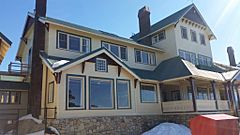
You used to be able to stay at the historic Mount Buffalo Chalet. This guest house was built in 1910. It closed for visitors in January 2007. However, Parks Victoria and the Victorian Government worked to fix up the outside and gardens of the Chalet in 2017 and 2018. The Chalet looks out over large granite rocks and offers views of the Ovens Valley and Buckland Valley below.
Another lodge, Tatra Inn, was located near the Cathedral. It was unfortunately destroyed by a bushfire in 2006.
Mount Buffalo is a great place for adventure! You can go rock climbing and abseiling here. It's also a popular spot for hang-gliding. If you like exploring, there's even adventure caving at Mount Buffalo. The camping ground at Lake Catani is open from November to April.
During winter, Mount Buffalo is perfect for cross-country skiing. There are many cross-country ski trails near the Cathedral (Cresta). You can also find toboggan runs at Dingo Dell and Cresta Valley. These are great for beginners. More experienced skiers can find lessons and many trails too. Visitors often stay in the nearby towns of Porepunkah and Bright.
A Look Back: History of Mount Buffalo
Long ago, the Mitambuta and Taungurong people would climb Mount Buffalo in summer. They came to feast on protein-rich bogong moths. They also used the area to meet and hold special ceremonies.
Explorers Hume and Hovell named the mountain in 1824. They thought it looked like a buffalo lying down. Later, gold miners and botanists visited the area.
Tourism started in the 1880s. Because of this, an area around the Gorge was made a national park in 1898. The park has grown bigger many times since then. Now, it includes the entire plateau and the slopes around it.
The Mount Buffalo Chalet was built in 1910. This happened soon after the first road to the plateau was made. The park became a popular holiday spot for many generations. It was also a place for early skiing and ice skating. Mount Buffalo even had the first ski tow in Australia!
When the Victorian Railways ran the Mount Buffalo Chalet, the restaurant was called an official "Railways Refreshment Room." Staff wore railway uniforms and even blew whistles!
Amazing Animals: Fauna of Mount Buffalo
Mount Buffalo National Park has many different types of animals. This is because the park has a wide range of altitudes, from lower forests to high plateaus.
In the foothill forests, you can find kangaroos and wallabies. There are also several kinds of possums and sugar gliders. Smaller mammals like native rats and mice live on the plateau. Wombats can be found in all parts of the park.
The alpine silver xenica is a special type of butterfly. It is only found on the plateau of Mount Buffalo. Bogong moths hide in rock cracks at The Horn. You can often see birds flying into the cracks to eat them during the day. Bats do the same at night! Peregrine falcons sometimes build their nests in the granite rock faces. Crimson rosellas, colorful birds, are very common throughout the park.
Plants of Mount Buffalo: Vegetation
The park is home to over 550 native plant species. The most important plant groups are those found in alpine and sub-alpine areas.
On the lower slopes, you'll see mixed gum and peppermint trees. This includes the bogong gum (Eucalyptus chapmaniana). As you go higher, around 1100 meters, you'll find pure stands of alpine ash (Eucalyptus delegatensis). Above 1300 meters, there are subalpine woodlands of snow gum (Eucalyptus pauciflora).
Most of the plateau is at 1500 meters high. Here, you'll find grasslands in the valleys. There are also bog and fen areas with Sphagnum and Empodisma plants near water.
A special type of eucalypt, the Eucalyptus mitchelliana, also called the Buffalo sallee, grows only on the higher granite rocks. Other plants found only here include Grevillea alpivaga (Buffalo grevillea), Acacia phlebophylla (Buffalo sallow wattle), and Babingtonia crenulata (fern-leaf baeckea). The rare Pratia gelida, or snow pratia, grows in a small area on Hospice Plain.
Grazing by animals was stopped in the park in 1957. This was one of the first times this happened in an alpine park. However, managing problem plants like Himalayan honeysuckle and blackberries is still a challenge.
Hidden Wonders: Fungi of Mount Buffalo
Mount Buffalo National Park also has a huge variety of fungi. Fungi are very important for the environment. They help break down dead plants and animals, returning nutrients to the soil.
Many plants in Mount Buffalo National Park (and around the world) have a special partnership with fungi. This is called a mycorrhizal relationship. The fungi help the plants get nutrients, and the plants provide food for the fungi.
Many different types of fungi are expected to live in the park. This is because of the great variety of plants, special habitats, and different climates. Hundreds of fungal species have already been recorded by nature lovers. You can find a list on the Atlas of Living Australia.
One type of fungus, Leotia lubrica, is commonly called the jelly baby. It grows in leaf litter, moss, and wet soils. These yellow, jelly-like fungi usually grow in clumps. Another unique species is the rhubarb bolete, Boletellus obscurecoccineus. It grows in the soil with Eucalyptus trees. The Australian group Fungimap helps track where fungi are found, including those in national parks.
Fires and Recovery: The 2006 Bushfires
In late 2006, big bushfires swept through parts of the national park. These fires were part of the huge 2006-07 Victorian Alps Fire Complex. The Cresta Lodge was destroyed by the fires. However, the historic Chalet was saved, even though it was thought to be in danger.
Cycling Adventures: Road Cycling
Mount Buffalo is a very popular place for road cyclists. The climb to the top of the mountain is challenging but offers amazing views. From the old tollbooth at the bottom to the Mount Buffalo Chalet, it's a 20.9 km climb. The average slope is 4.8%. Cyclists can make the ride even longer by continuing past the Chalet turn-off to Dingo Dell or The Horn.


